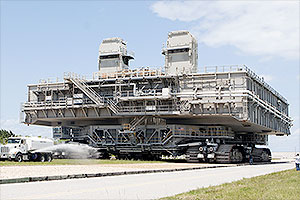August 5, 2021 — When NASA announced earlier this year that it was going to destroy one of its three historic structures that was used to support Apollo rockets and space shuttles, the fate of Mobile Launch Platform-2 (MLP-2) seemed to be sealed as scrap metal. That is, until fans of MotoArt's PlaneTags heard the news.
Now, the public can own a small part of space shuttle history, thanks to a 20-year-old company with a reputation for preserving aviation history by making products out of old airplane parts.
In addition to its business of making high-end furniture out of retired airframes, MotoArt also came up with the idea for PlaneTags — luggage tags fabricated from the skin of one of more than 100 different types of aircraft, from a B-29 bomber to a DC-9 airliner to an SR-71 Blackbird reconnaissance aircraft.
How great would it be, MotoArt's patrons said, if some of MLP-2 could be similarly saved to make into a PlaneTag.
"That's exactly how it started," Dave Hall, MotoArt PlaneTags owner, said in an interview with collectSPACE. "We have a fan club on Facebook and immediately everyone started emailing me. I probably got a half a dozen emails in one night about the dismantling of the MLP."
Even though they had in the past flirted with the edges of space history — PlaneTags have been made from a Titan II missile and the Boeing 747 that served as a parts donor for the Stratolaunch carrier aircraft — MotoArt had never worked with NASA before and so Hall did not know if an MLP-2 tag was even a possibility.
"We literally started emailing just about everyone we knew at NASA and it kind of went straight up to the top," said Hall. "We explained what we wanted to do, sent them a few samples of our product and they were actually excited about it."
There was only one problem: by the time Hall reached the right people, MLP-2 was no longer NASA property. As part of its contract to conduct the demolition and disposition of the platform, Frank-Lin Services of Brevard in Melbourne, Florida, had been awarded ownership of the massive structure.
So Hall jumped on a plane for a cross-country trip to Kennedy Space Center to meet with Frank-Lin, who quickly came on board with the idea — and invited Hall to board MLP-2.
The 25-foot-high by 160-foot-long by 135-foot-wide (8 by 50 by 40-m) mobile launch platform was in use by NASA for more than 40 years between 1968 and 2011. First referred to as Mobile Launcher-2 (ML-2), it supported five Saturn V launches, including the Apollo 12 and Apollo 14 moon landing missions, as well as the flight that put the first U.S. space station, Skylab, into Earth orbit.
The platform was then modified to support 46 space shuttle launches, including the first flight of every winged orbiter with the exception of the first, STS-1 with Columbia, and missions to deploy and service the Hubble Space Telescope, return Mercury astronaut John Glenn to orbit and help assemble the International Space Station. MLP-2 was also in use for STS-51L, the 1986 ill-fated flight of Challenger and its seven-person crew.
Partial to the shuttle as a space plane, Hall knew exactly what part of MLP-2 he wanted: the two tail service masts that fed propellant into the shuttle's external fuel tank and supported the electrical connections between the vehicle and pad.
"We felt like that was the most identifiable when we walked the platform," said Hall. "It was also probably one of the more easy parts to take down in sections."
After getting the masts shipped out to MotoArt's facilities in southern California, work began on how to best section it into PlaneTags. The steel was much thicker than their typical tag.
"I couldn't punch a hole in it and make it a keychain. This is more of a memento," Hall told collectSPACE.
Ultimately, the MLP-2 tail service mast metal was cut down to 3-inch (8-cm) ovals, each half an inch (1.3 cm) thick. The tags are polished, removing any exterior paint and other materials that could be harmful, but leaving a pitted metal surface.
Each tag is laser-inscribed "Mobile Launch Platform MLP-2 Genuine Metal" and is individually serialized with artwork depicting NASA's logo and a space shuttle on the MLP with one of the two tail service masts clearly visible.
The tags are held by magnet to a descriptive metal backing card, allowing them to easily be displayed on the card (as some PlaneTag enthusiasts are fond to do) or separately. Limited to 20,000 pieces, the MLP-2 PlaneTag retails for $249.95. An introductory 15 percent discount is available for the first 24 hours through the new PlaneTags iOS app.
"It is not an aircraft, of course. It is not the space shuttle... but it's the closest thing that people can actually touch and hold," said Hall. |
|

MotoArt's NASA MLP-2 PlaneTag is made from the genuine metal of the tail service masts from NASA's now-scrapped Mobile Launch Platform-2 in support of the space shuttle. (MotoArt/collectSPACE)

Mobile Launch Platform-2 (MLP-2) is seen being moved to a park site in the Launch Complex 39 area at Kennedy Space Center in Florida in May 2014. Between 1968 and 2011, MLP-2 was involved in the launch of 51 Apollo and shuttle missions. (NASA/Kim Shiflett)

MotoArt's NASA MLP-2 PlaneTag comes attached by magnet to a metal descriptive backer card for display or storage. (MotoArt) |
